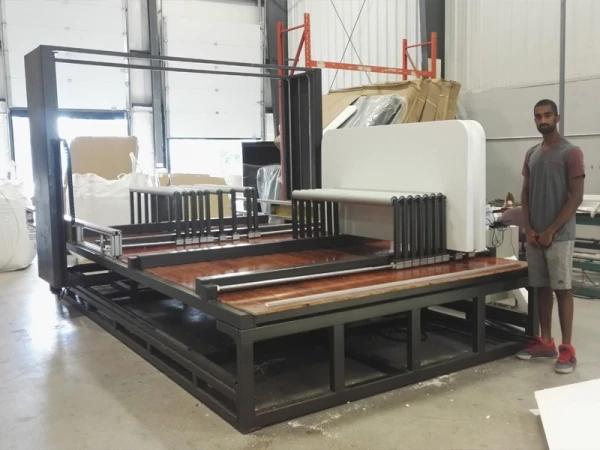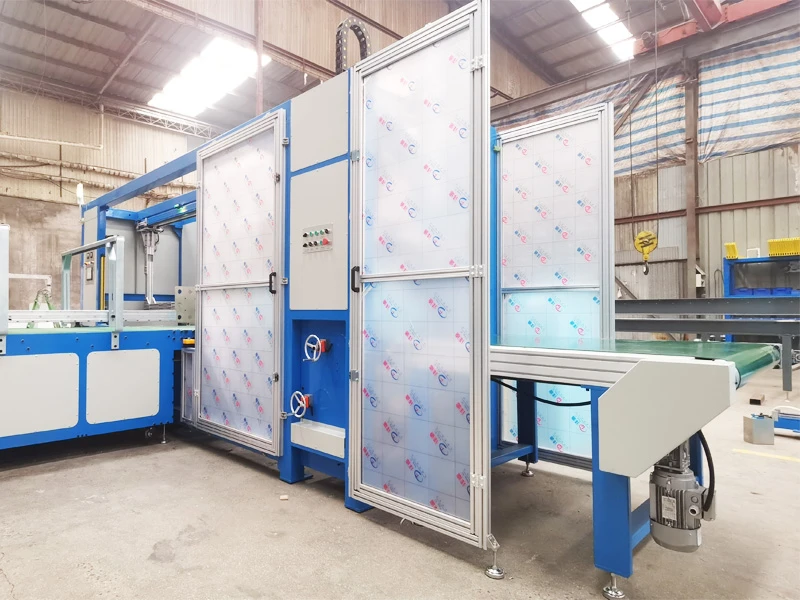Are you working with foam for insulation, crafting projects, or industrial applications and need a reliable way to achieve precise cuts? This article dives deep into the world of foam cutting tools, focusing on everything from simple knives to advanced hot wire cutters. We’ll explore which tool for cutting foam works best for your specific needs, helping you avoid making a mess and ensure a smooth, professional finish. Understanding the right foam cutting tool can save you time, effort, and material waste.
What Makes a Good Foam Cutting Tool for Insulation?
When it comes to foam cutting for insulation, the primary goal is usually a straight cut that fits snugly without gaps. A good tool for cutting insulation foam needs to be able to handle various types of foam, including styrofoam and polystyrene, cleanly and efficiently. Key characteristics include a sharp blade (or a hot wire), the ability to maintain a straight edge during the cutting process, and minimal dust or debris. For insulation board, you might need a tool capable of cutting thick foam accurately.
Consider the material you’re working with. Expanded polystyrene (EPS) is common for insulation and can be cut with various tools. Extruded polystyrene (XPS) is denser and might require a more robust cutting tool. The ideal tool will minimize tearing or crumbling, ensuring the cleanest possible edge for optimal insulation performance.
Why Consider a Hot Wire Cutter for Foam Carving?
For intricate designs and foam carving, a hot wire cutter stands out as an exceptional choice. This foam cutting tool utilizes a thin, electrically heated nichrome wire that becomes hot enough to melt through the foam like butter. This method allows for smooth, precise curves and shapes that are difficult to achieve with traditional knife blades. The heat seals the edges as it cuts, resulting in a clean finish with minimal debris.
Using a hot wire foam cutter is particularly beneficial when working with softer foams where a knife might drag or tear. The hot wire glides through the material, making it ideal for creating models, prototypes, and decorative pieces. While it requires a bit of practice to master the speed and pressure, the results are often far superior for intricate work compared to other tools to use.
Can You Achieve a Straight Cut on Foam with a Utility Knife?
Yes, a utility knife can be used to cut foam, especially thinner sheets, but achieving a consistently clean straight cut requires skill and patience. A sharp blade is crucial, and it’s often helpful to use a straight edge as a guide. Multiple passes with light pressure are better than trying to force the knife through in one go, which can lead to jagged edges and uneven cuts.
However, when working with thicker foam board or rigid foam insulation, a utility knife can become cumbersome and may not produce the precise cut needed. The risk of the blade binding or wandering off course increases with thickness. For thicker materials, specialized foam cutters or a hot knife might be more appropriate to ensure square cuts and avoid making a mess.
What is the Best Way to Cut Thick Styrofoam Insulation Board?
Cutting thick styrofoam insulation board presents a different challenge compared to thinner sheets. While a utility knife might work for small adjustments, a hot wire cutter or a specialized foam cutting tool designed for thicker materials often provides the best way to cut. A long blade or wire is necessary to pass through the entire thickness without repeatedly starting and stopping, which can create uneven edges.
A hot knife, which is essentially a knife with a heated blade, can also be very effective for cutting thick insulation. The heat helps the blade glide through the styrofoam with less resistance, resulting in a cleaner cut. Using a straight edge as a guide is still recommended, regardless of the tool for cutting chosen. Safety precautions are important when using heated tools, ensuring adequate ventilation to avoid inhaling fumes.
When Should You Use a Hot Knife for Foam Cutting?
A hot knife is a versatile foam cutting tool that bridges the gap between a standard knife and a hot wire cutter. It’s particularly useful when you need a clean cut on denser foams or when creating beveled edges. The heated blade melts the foam as it cuts, minimizing tearing and leaving a smooth, sealed edge.
Using a hot knife is advantageous for projects where aesthetics are important, as it produces a professional-looking finish. It’s also a good option for cutting 2 inch foam or thicker materials where a standard knife might struggle. However, similar to hot wire cutters, it’s essential to work in a well-ventilated area due to potential fumes and to allow the blade to do the work, avoiding excessive pressure.
Are There Different Types of Hot Wire Foam Cutters Available?
Yes, hot wire foam cutters come in various designs to suit different applications and scales of work. Smaller, handheld models are ideal for crafts and hobbyists, offering portability and maneuverability for detailed foam carving. Larger table-mounted hot wire cutters provide a stable platform for cutting foam boards and creating more consistent straight cuts.
Industrial-grade hot wire cutting machines, like our EPS Cutting Machine, offer advanced features for high-volume production, including precise control systems and the ability to handle large foam blocks. These machines, often used in foam factories, can be integrated into automated cutting lines for maximum efficiency. The choice of hot wire cutter depends on the size and complexity of your projects and the volume of foam you need to cut.
How Can You Ensure a Clean Cut When Working with Rigid Foam Insulation?
Achieving a clean cut on rigid foam insulation involves selecting the right tool for the job and employing proper technique. Using a sharp knife or a hot knife with a guiding straight edge is crucial. Make sure the blade is long enough to cut through the entire thickness in one pass if possible.
For hot wire cutting, ensure the wire is taut and the temperature is appropriate for the type of foam. Moving the cutter at a consistent speed prevents melting or tearing. Avoid applying excessive pressure, let the heat do the work. Practicing on scrap pieces is always a good idea to get a feel for the cutting process and adjust your technique for the best way to cut. Remember, a slow and steady approach often yields the cleanest results.
Is a Jigsaw a Viable Tool for Cutting Foam Boards?
While a jigsaw can be used to cut foam boards, it’s generally not the ideal tool for cutting for achieving a precise and clean finish, especially with softer foams like EPS. The teeth of the saw blade can sometimes tear or shred the foam, leaving a rough edge. However, for thicker, denser foams like XPS, a jigsaw with a fine-tooth blade designed for plastics can be used with careful control.
When using a jigsaw, it’s important to use a low speed and avoid pushing the saw too quickly. A straight edge can be clamped to the foam board to guide the saw for long straight cuts. However, for the cleanest and most accurate results, especially for intricate cuts or when working with EPS, a hot wire cutter or a hot knife is usually preferred.
What are the Key Advantages of Using Specialized Foam Cutters?
Specialized foam cutters, including hot wire cutters and hot knives, offer several key advantages over traditional cutting tools like utility knives or saws. Firstly, they provide a much cleaner and smoother cut, especially on softer foams like styrofoam. The heat melts the foam, preventing tearing and creating a sealed edge.
Secondly, specialized foam cutters allow for more intricate and precise cuts, making them ideal for foam carving and creating custom shapes. They reduce material waste by ensuring accurate cuts the first time. Furthermore, while there might be some fume produced with heated tools, the overall mess is often less compared to the dust and debris generated by sawing. Investing in the right tool can significantly improve the quality and efficiency of your foam cutting projects. Our CNC EPS Cutting Machine exemplifies this advantage by offering automated precision for complex shapes.
How to Choose the Right Tool for Your Foam Cutting Needs?
Choosing the right tool for cutting depends on several factors:
- Type of Foam: Softer foams like EPS are well-suited for hot wire cutters, while denser foams like XPS might handle utility knives or hot knives better.
- Thickness of Foam: Thicker boards may require longer blades or hot wires found in specialized tools.
- Type of Cut: For straight cuts, a sharp knife with a straight edge or a table-mounted hot wire cutter works well. For curves and intricate designs, a handheld hot wire cutter or a hot knife is ideal.
- Volume of Work: For high-volume production, consider investing in automated machinery like our EPS Cutting Line.
- Budget: Utility knives are the most affordable, while specialized hot wire cutters and industrial machines represent a larger investment.
Consider your specific cutting needs and the desired finish. If you need a precise cut with a sealed edge, a hot wire or hot knife is the way to go. For basic straight cuts on thinner materials, a sharp knife might suffice. Don’t hesitate to explore different tools available and perhaps even try a few to see what work best for you. Remember, having the right tool ensures a smooth and efficient cutting process. For high-volume needs, remember our Automatic EPS Conveyor can streamline your material handling.
In summary, remember these key points:
- Hot wire cutters excel at intricate cuts and leave a smooth, sealed edge.
- Hot knives are versatile for denser foams and beveled edges.
- Sharp utility knives are suitable for basic cuts on thinner foam with a straight edge.
- Specialized foam cutters offer superior precision and efficiency.
- Always prioritize safety and work in a well-ventilated area when using heated tools.
By understanding the different types of foam cutting tools and their applications, you can make informed decisions to achieve the best results for your foam projects.
Post time: 01-14-2025







